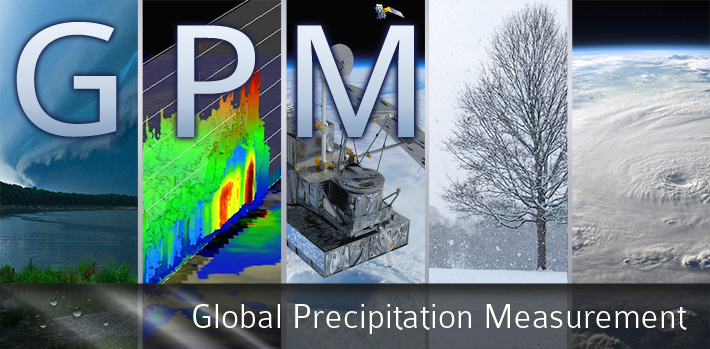Global Precipitation Measurement (GPM) Ground Validation
System for Integrating Multi-platform data to Build the Atmospheric column
(SIMBA)
 |
Current SIMBA Version: v1.6.1 (03 May 2018)
Motivated by NASA's Global Precipitation Measurement (GPM) mission and Ground
Validation objectives, the System for Integrating Multi-platform data to Build
the Atmospheric column (SIMBA) has been developed as a unique multi-sensor
precipitation data fusion tool to unify field observations recorded in a
variety of formats and coordinate systems into a common reference frame.
Through platform-specific modules, SIMBA processes data from native coordinates
and resolutions only to the extent required to set them into a user-defined,
three-dimensional grid. At present, the system supports several ground-based
scanning research radars, NWS NEXRAD radars, profiling Micro Rain Radars (MRRs),
multiple disdrometers and rain gauges, soundings, the GPM Microwave Imager and
Dual-frequency Precipitation Radar on board the Core Observatory satellite, and
Multi-Radar/Multi-Sensor quantitative precipitation estimates. SIMBA generates
a new atmospheric column data product that contains a concomitant set of all
available data from the supported platforms within the user-specified grid
defining the column area in the versatile NetCDF format, with key parameters
for each data source preserved as attributes.
Targeted applications for the SIMBA tool have initially been datasets collected
at part of:
From this page you can download the current version of SIMBA, which includes
example input/output data files, and view system documentation as well as an
informal tutorial.
|
Download Current SIMBA Package and Sample Data
The packaged library of SIMBA code is available as a .tar.gz archive.
This archive also includes example input and output data files.
Providing a valid email address to access the download allows you to be
contacted with news of future SIMBA improvements and new releases.
Download the SIMBA Package:
SIMBA v1.6.1 Code
(file size > 400 MB)
SIMBA Documentation, Dependencies and Tutorial
Documentation:
These files provide details on the entire SIMBA framework,
including the platform-specific modules, format of data structures passed among
the SIMBA components, and a running list of improvements to the system included
with each version release.
Dependencies:
The SIMBA framework is written in the IDL language and is freely available
from NASA. In addition to IDL, the following (freely available) tools are
required for running SIMBA on your system:
Tutorial:
The following informal tutorial is provided by the NASA Wallops Precipitation
Research Facility as an example for users getting started with SIMBA:
SIMBA References & Example Science Applications
Thorough descriptions of the SIMBA precipitation observation fusion
framework are available in the following papers:
-
Charanjit S. Pabla, David B. Wolff, David A. Marks, Stephanie M. Wingo, and Jason L. Pippitt, 2022:
GPM Ground Validation at NASA Wallops Precipitation Research Facility.
Link:
doi: 10.1175/JTECH-D-21-0122.1
-
Wingo, S. M., W. A. Petersen, P. N. Gatlin, C. S. Pabla, D. A. Marks, and
D. B. Wolff, 2018: The System for Integrating Multi-platform data to Build
the Atmospheric column (SIMBA) precipitation observation fusion framework.
Link:
doi: 10.1175/JTECH-D-17-0187.1
Additional works that have documented development and demonstrated the
utility of the system by providing example applications of SIMBA have
included:
-
Wingo, S. M., W. A. Petersen, P. N. Gatlin, D. A. Marks, D. B. Wolff,
and C. S. Pabla, 2017: Evaluating precipitation observed in complex terrain
during GPM field campaigns with the SIMBA data-fusion tool. American Geophysical
Union, 2017 Fall Meeting, New Orleans, LA.
-
Pabla, C. S., S. M. Wingo, D. B. Wolff, D. A. Marks, W. A. Petersen, and
P. N. Gatlin, 2017: Comparing GPM satellite to ground platform measurements:
Case studies from the NASA Wallops Precipitation science Research Facility.
American Meteorological Society, 38th Conference on Radar Meteorology, Chicago, IL.
-
Wingo, S. M., W. A. Petersen, P. N. Gatlin, D. A. Marks, C. S. Pabla,
and D. B. Wolff, 2017: Applying the SIMBA data fusion framework to OLYMPEX:
Multi-platform observational analysis of an intensively sampled orographically
enhanced precipitation event. American Meteorological Society, 38th Conference
on Radar Meteorology, Chicago, IL.
-
Wingo, S. M., D. A. Marks, D. B. Wolff, and W. A. Petersen, 2016:
Building the column: Ground-up integration of multi-sensor precipitation
observations. American Geophysical Union, 2016 Fall Meeting, San Francisco, CA.
|




